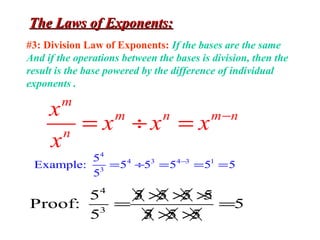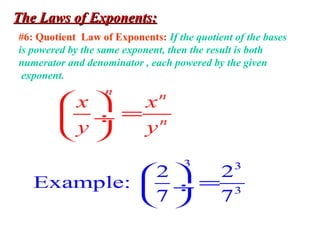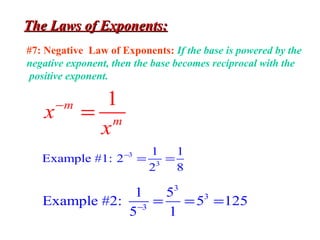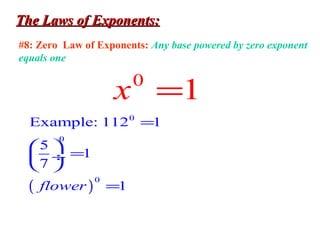Rules of Exponents
- 1. ExponentsExponents { 3 5power base exponent 3 3 means that is the exponential form of t Example: he number 125 5 5 .125 =
- 2. The Laws of Exponents:The Laws of Exponents: #1: Exponential form: The exponent of a power indicates how many times the base multiply itself. n n times x x x x x x x x − = × × ×××× × × ×144424443 3 Example: 5 5 5 5= × ×
- 3. The Laws of Exponents:The Laws of Exponents: #2: Multiplicative Law of Exponents: If the bases are the same And if the operations between the bases is multiplication, then the result is the base powered by the sum of individual exponents . m n m n x x x + × = 3 4 3 4 7 Example: 2 2 2 2+ × = = ( ) ( )3 4 7 Proof: 2 2 2 2 2 2 2 2 2 2 2 2 2 2 2 2 2 × = × × × × × × = × × × × × × =
- 4. The Laws of Exponents:The Laws of Exponents: #3: Division Law of Exponents: If the bases are the same And if the operations between the bases is division, then the result is the base powered by the difference of individual exponents . m m n m n n x x x x x − = ÷ = 4 4 3 4 3 1 3 5 Example: 5 5 5 5 5 5 − = ÷ = = = 4 3 5 5 5 5 5 Proof: 5 5 5 5 5 × × ×/ = = × ×/
- 5. The Laws of Exponents:The Laws of Exponents: #4: Exponential Law of Exponents: If the exponential form is powered by another exponent, then the result is the base powered by the product of individual exponents. ( ) nm mn x x= ( ) 23 3 2 6 Example: 4 4 4× = = ( ) ( ) ( ) ( ) 2 23 6 Proof: 4 4 4 4 4 4 4 4 4 4 4 4 4 4 4 4 4 = × × = × × × × × = = × × × × × =
- 6. The Laws of Exponents:The Laws of Exponents: #5: Product Law of Exponents: If the product of the bases is powered by the same exponent, then the result is a multiplication of individual factors of the product, each powered by the given exponent. ( ) n n n xy x y= × ( ) 22 2 2 2 2 Proof: 2 3 4 9 Example: 36 6 2 3 2 3 36 = = × = × × = × =
- 7. The Laws of Exponents:The Laws of Exponents: #6: Quotient Law of Exponents: If the quotient of the bases is powered by the same exponent, then the result is both numerator and denominator , each powered by the given exponent. n n n x x y y = ÷ 3 3 3 2 2 Example: 7 7 = ÷
- 8. The Laws of Exponents:The Laws of Exponents: #7: Negative Law of Exponents: If the base is powered by the negative exponent, then the base becomes reciprocal with the positive exponent. 1m m x x − = 3 3 1 1 Example #1: 2 2 8 − = = 3 3 3 1 5 Example #2: 5 125 5 1− = = =
- 9. The Laws of Exponents:The Laws of Exponents: #8: Zero Law of Exponents: Any base powered by zero exponent equals one 0 1x = ( ) 0 0 0 Example: 112 1 5 1 7 1flower = = ÷ =
- 10. The Laws of Exponents:The Laws of Exponents: #8: Zero Law of Exponents: Any base powered by zero exponent equals one 0 1x = ( ) 0 0 0 Example: 112 1 5 1 7 1flower = = ÷ =









